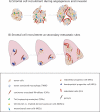Migratory neighbors and distant invaders: tumor-associated niche cells
- PMID: 18316475
- PMCID: PMC2731657
- DOI: 10.1101/gad.1636908
Migratory neighbors and distant invaders: tumor-associated niche cells
Abstract
The cancer environment is comprised of tumor cells as well as a wide network of stromal and vascular cells participating in the cellular and molecular events necessary for invasion and metastasis. Tumor secretory factors can activate the migration of host cells, both near to and far from the primary tumor site, as well as promote the exodus of cells to distant tissues. Thus, the migration of stromal cells and tumor cells among specialized microenvironments takes place throughout tumor and metastatic progression, providing evidence for the systemic nature of a malignancy. Investigations of the tumor-stromal and stromal-stromal cross-talk involved in cellular migration in cancer may lead to the design of novel therapeutic strategies.
Figures


Similar articles
-
Tumor metastasis: molecular insights and evolving paradigms.Cell. 2011 Oct 14;147(2):275-92. doi: 10.1016/j.cell.2011.09.024. Cell. 2011. PMID: 22000009 Free PMC article. Review.
-
Invasion and metastasis.Curr Opin Oncol. 1992 Feb;4(1):134-41. doi: 10.1097/00001622-199202000-00018. Curr Opin Oncol. 1992. PMID: 1375513 Review.
-
Exosome-Mediated Metastasis: Communication from a Distance.Dev Cell. 2019 May 6;49(3):347-360. doi: 10.1016/j.devcel.2019.04.011. Dev Cell. 2019. PMID: 31063754 Review.
-
The Extracellular Matrix Modulates the Metastatic Journey.Dev Cell. 2019 May 6;49(3):332-346. doi: 10.1016/j.devcel.2019.03.026. Dev Cell. 2019. PMID: 31063753 Free PMC article. Review.
-
Tumour-associated host cells participating at invasion and metastasis : targets for therapy?Acta Chir Belg. 2006 Nov-Dec;106(6):635-40. doi: 10.1080/00015458.2006.11679971. Acta Chir Belg. 2006. PMID: 17290685 Review.
Cited by
-
2-Hydroxyestradiol Overcomes Mesenchymal Stem Cells-Mediated Platinum Chemoresistance in Ovarian Cancer Cells in an ERK-Independent Fashion.Molecules. 2022 Jan 26;27(3):804. doi: 10.3390/molecules27030804. Molecules. 2022. PMID: 35164068 Free PMC article.
-
High expression of IGFBP7 in fibroblasts induced by colorectal cancer cells is co-regulated by TGF-β and Wnt signaling in a Smad2/3-Dvl2/3-dependent manner.PLoS One. 2014 Jan 10;9(1):e85340. doi: 10.1371/journal.pone.0085340. eCollection 2014. PLoS One. 2014. PMID: 24427302 Free PMC article.
-
The Stem Cell Network model: clinical implications in cancer.Eur Arch Otorhinolaryngol. 2009 Feb;266(2):161-70. doi: 10.1007/s00405-008-0809-3. Epub 2008 Sep 20. Eur Arch Otorhinolaryngol. 2009. PMID: 18807062 Review.
-
M402, a novel heparan sulfate mimetic, targets multiple pathways implicated in tumor progression and metastasis.PLoS One. 2011;6(6):e21106. doi: 10.1371/journal.pone.0021106. Epub 2011 Jun 16. PLoS One. 2011. PMID: 21698156 Free PMC article.
-
Tumor-infiltrating myeloid cells activate Dll4/Notch/TGF-β signaling to drive malignant progression.Cancer Res. 2014 Apr 1;74(7):2038-49. doi: 10.1158/0008-5472.CAN-13-3118. Epub 2014 Feb 11. Cancer Res. 2014. PMID: 24520074 Free PMC article.
References
-
- Ara T., Tokoyoda K., Sugiyama T., Egawa T., Kawabata K., Nagasawa T. Long-term hematopoietic stem cells require stromal cell-derived factor-1 for colonizing bone marrow during ontogeny. Immunity. 2003;19:257–267. - PubMed
-
- Arafat W.O., Casado E., Wang M., Alvarez R.D., Siegal G.P., Glorioso J.C., Curiel D.T., Gomez-Navarro J. Genetically modified CD34+ cells exert a cytotoxic bystander effect on human endothelial and cancer cells. Clin. Cancer Res. 2000;6:4442–4448. - PubMed
-
- Asou Y., Rittling S.R., Yoshitake H., Tsuji K., Shinomiya K., Nifuji A., Denhardt D.T., Noda M. Osteopontin facilitates angiogenesis, accumulation of osteoclasts, and resorption in ectopic bone. Endocrinology. 2001;142:1325–1332. - PubMed
-
- Atula S., Grenman R., Syrjanen S. Fibroblasts can modulate the phenotype of malignant epithelial cells in vitro. Exp. Cell Res. 1997;235:180–187. - PubMed
Publication types
MeSH terms
Grants and funding
LinkOut - more resources
Full Text Sources
Other Literature Sources
